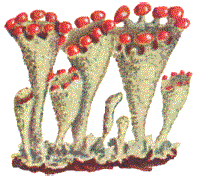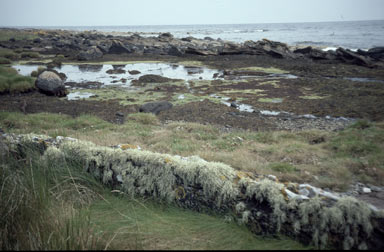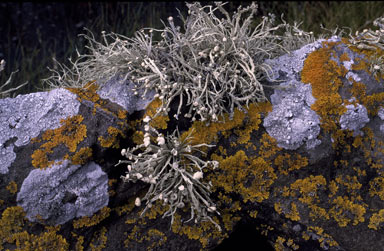 Chemistry
Chemistry
Chemistry and taxonomy
Chemical testing is now a standard identification tool, though it took some decades for it to be universally accepted. But even though chemical testing has been in use for a long time as an aid in identification there has been continuing controversy over the role of chemistry in distinguishing species.
Initially lichen taxonomy was based on naked-eye morphology. With the development of good quality microscopes various microscopic features began to be used in taxonomy but this was still an approach based on morphology, albeit now making use of both macroscopic and microscopic morphology. Chemistry gives additional information about lichens and the important point is that:
Most morphologically defined species have a constant chemistry, irrespective of their geographic origin, substrate or ecology, and this justifies the use of chemistry in lichen taxonomy
.
The discovery of chemical differences has been used as additional evidence in support of distinguishing species that are already morphologically distinct. For example the species Punctelia borreri and Punctelia subrudecta show some morphological differences but they also differ chemically - the former producing gyrophoric acid as the major secondary metabolite and the latter producing lecanoric acid. If, as in this case, chemistry is consistent with known morphological differences, there is no controversy. But what about the reverse, with chemistry (not morphology) as the driving force. Put very simply the question is: Should two specimens which differ in chemistry, but which are morphologically indistinguishable, be considered as two different species (with distinct chemistries) or as two examples of the one species (with a variable chemistry)?
|
Often, when chemical differences have been found in a given species, re-examination of all the evidence has shown other differences - for example, geographical, ecological or in micro-morphology. Sometimes some or all of the additional differences may already have been observed, but been thought to be of little significance, simply the sort of minor variations you find in any species. However, if the chemistries are quite distinct, in what has been regarded as a single species, it is worthwhile re-examining all the evidence about the species in question, to see if any other features correlate with chemical differences. Where there is clear, correlated evidence many would accept that there are in fact two (or oven more) species where previously there was thought to be just one. Where the other evidence is ambiguous there's scope for debate. However, even those who would not accept the existence of more than one species would nevertheless recognize the chemical differences by saying that within the one species there are two (or more) chemical races or chemotypes![]() .
.
Chemical variation
|
There are a number of patterns of variation between chemotypes. One very common variation is referred to as replacement where the principal secondary metabolite in one chemotype is completely replaced by a different metabolite in the other chemotype. Hence the principal metabolite in the first chemotype is lacking from the second chemotype and vice versa. There are also minor variants of the replacement theme, for example, one chemotype having metabolites A and B while a second chemotype is a deficient strain in that while it has compound A it lacks B and has no metabolite in place of B. A classic example of replacement was the species Pseudevernia furfuracea which was considered to show three chemotypes; one from northern Europe (containing olivetoric acid), one from southern Europe and North Africa (with physodic acid) and the third from North America (with lecanoric acid). From a chemical viewpoint the first two Pseudevernia furfuracea chemotypes are very closely related since one of the acids can be obtained from the other by just one biosynthetic step. However, the third chemotype is distant from the other two since lecanoric acid is not biosynthetically related to either of the other two acids. This fact, and the isolation of the American chemotype from the European chemotypes, led to the former being described as a distinct species - Pseudevernia consocians. In another type of variation two chemotypes have one or more secondary metabolites in common but one of the chemotypes has one or more additional, or accessory, compounds. Numerous examples of the accessory type of variation are known but rarely with any correlating morphological or distributional features. An example is the species Xanthoparmelia flavescentireagens, widespread in Australia and also found in New Zealand. In this species usnic acid, loxodon and norlobaridone are always present but with constipatic acid or protoconstipatic acid also present sometimes.
Once chemical testing had become well-established it was thought that replacement and accessory compound variations accounted for all chemotype variation. Indeed, in 1970 William Culberson had summarised the then current view by noting that:
Chemical races originate through a change in the constituent natural products according to one of two patterns, (a) the consistent replacement of one substance by another or (b) the addition (or deletion) of one or more accessory substances![]() .
.
However, six years later he was the co-author of a paper that revealed the existence of another form of variation between chemotypes, called chemosyndromic variation. A chemosyndrome is a group of biosynthetically related compounds. In many lichens a secondary metabolite that is present as a major compound will be accompanied by biosynthetically related compounds that are present in lesser concentrations. It won't surprise you to hear that a great variety of chemosyndromes can be found in the lichens. What is particularly interesting is that there are chemosyndromes that 'overlap', that is where one (or more) metabolites are common to two or more chemosyndromes and, moreover, where the major secondary metabolite in one chemosyndrome is a minor metabolite in (or absent from) another chemosyndrome. Consider the following scenario involving three lichens which, between them, contain five secondary metabolites called A, B, C, D and E that are biosynthetically related in various ways. Two of the lichens contain three of those metabolites and the other contains four, in the arrangements shown below. For each lichen the major metabolite is shown by a large, bold letter. These give an example of chemosyndromic variation.
A B C A B C D B D E
![]()
Sibling species
Sibling species are those that do not interbreed but are hard to tell apart by morphological features. If you search for more information about sibling species (of which there are many plant or animal examples) you are likely to come across the expression reproductively isolated, and to say that two species are reproductively isolated is simply another way of saying that they don't interbreed. Clearly, if two species are geographically separated and never come into contact they are also reproductively isolated but it's also easy to see that reproductively isolated species need not be geographically separated. After all, if you keep a dog and a duck as household pets they are reproductively isolated but geographically very close! Of course, those pets are not sibling species since they are morphologically distinct. While sibling species may be difficult to distinguish morphologically there are many instances where some non-morphological feature allows easy differentiation. For example a pair of sibling species might have different calls, or perhaps they eat different foods or inhabit different ecological niches within the same geographical area - and of course some sibling species are separated geographically.
Getting back to the subject of lichens, often there are good grounds for considering the different chemotypes within a morphologically uniform 'species' as being sibling species - and of course then giving the different chemotypes their own species names. The chemotypes within each such morphological species need to be critically examined (along with any non-chemical evidence) to ensure there is good evidence to support sibling species, since not all chemical variation warrants species status. For example sporadic variation by accessory compounds, uncorrelated to any other features, is of no taxonomic value![]() .
.
The subject of correlation has come up again and while correlation is always suggestive, it needs to be treated carefully. For example, suppose that there are two chemotypes (impossible to distinguish morphologically) that seem perfectly correlated with substrate, with one chemotype having been found growing only on bark and the other always on rock. On the basis of just those two pieces of evidence (namely, chemistry and substrate) some might argue, quite logically, that it is substrate that induces chemical variation. That is, we have one chemically variable species, the variation caused by the substrate. Others could argue, quite logically, that we have two sibling species with one able to survive only on bark and the other only on rock and that if a propagule of the 'bark' species lands on rock it would fail to grow (and vice versa for a propagule of the 'rock' species landing on bark). Yes, that is a simplistic scenario, but the point is that the evidence is consistent with two contradictory hypotheses and, without further evidence, it is impossible to choose between the two. One thing clear from this scenario is that we would have an intriguing morphological species that warrants more investigation and the initial 'perfect' correlation is just a starting point. Perhaps more careful searching would reveal that occasionally the bark chemotype can be found on rock (or vice versa) or someone may be able to grow the chemotypes on the 'wrong' substrates. If either of those happened we'd conclude that the chemotypes are not restricted to different substrates (though one chemotype appears to have a strong preference for bark and the other for rock) so substrate can't be the sole determinant of chemistry. Does further searching show that the different chemotypes can grow very close to each other? If that does happen, is there evidence of interbreeding and hence evidence in support of the chemotypes belonging to one, chemically variable species? There are various other aspects that could be studied and sometimes the additional investigation may be quite demanding. Ramalina siliquosa, a common fruticose lichen on seaside rocks in Europe, shows both chemical complexity and, in at least one location, several different chemotypes living very close together.
|
|
In the past two decades various lichen mycobionts have had their DNA or RNA analysed. Such molecular analyses have sometimes yielded taxonomic evidence consistent with morphology or chemistry and at other times not. In some cases the molecular evidence supports all chemotypes as distinct species. In other cases the molecular evidence doesn't go that far but might, for example, support the splitting of a chemically very variable morphological species into two sibling species, each still chemically variable. It is interesting to note that the use of molecular analyses has generated taxonomic controversy, and not just with lichens. Whenever a new technique is introduced some controversy is usual, simply because the new results typically agree with some older conclusions and disagree with others. There will be questions about the reliability of the new technique, its precision, about how widely applicable it is and so on. Initial results may be only suggestive and subject to revision as the technique is improved or extended. For example, as more of an organism's genome is studied by molecular techniques the inferences from the early molecular analysis of that organism may need to be changed. At present molecular analyses are still relatively new in lichen taxonomy so what the results from such analyses will say about many chemotypic variations is still unknown.
Lichen chemistry pages on this website Chemistry and taxonomy |
![An Australian Government Initiative [logo]](/images/austgovt_brown_90px.gif)



